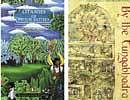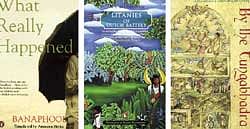

Indian writing in English has begun to resemble grass after a lavish rain. Step into a bookstore and you see a crop of books — eager, full of hope, lovely to look at. Next time you visit the same store, it has been mowed down. But, not to fear. There is a fresh crop of equally energetic and bouncy looking, indistinguishable from each other titles. The problem with grass is that it can’t hold its own for long. Only here and there on the literary landscape do you spot a rare tree or a few hardy shrubs doing their own thing. But mostly titles come and titles go — their shelf life not much longer than that of the glossy magazines on the racks.
Why, of late, are we producing a literature that is so ephemeral? Perhaps, because the soil we stand on is too thin, our roots going in barely a few inches deep. Citizens of an increasingly globalised world, more of us than ever before read and write English as our first language. The connect with the mother tongue has weakened to the extent that while many still speak it fluently, few are equally adept at reading and writing in it. And so, without quite meaning to, we’ve thrown away the keys to our own inheritance — the literature of our forefathers — and are left standing on shallow soil producing a literature which is correspondingly stunted.
Other factors have contributed to this state of rootlessness. Rushdie, by winning the Booker, made Midnight’s Children out of us all, flush on our own cleverness and irreverent of our own history. In the Foreword to The Vintage Book of Indian Writing, 1947-1997, an anthology he edited to mark 50 years of Indian writing after Independence, he declared Indian Writing in English to be a stronger and more important body of work than most of what has been produced in the ‘16 official languages’ of India, the so-called ‘vernacular languages’, thereby putting his stamp of approval on our foolish ignorance of the works of great writers such as O V Vijayan, Qurratulain Haider, Ismat Chughtai, U R Ananthamurthy, Mahasweta Devi, M T Vasudevan Nair and Sunil Gangopadhyaya, to name only a few.
The other set of roots we had connected us to the Western literary traditions — to Tolstoy and Chekov, to Dickens and Austen, to Hemingway and Steinbeck. But the stupendous success of Chetan Bhagat’s colloquial right-out-of-our-own-lives English put a quick scissor through those. The Indian writer in English, long ago absolved of knowing what ‘Indian’ literature was about, was now also absolved of the requirement to know what ‘English’ literature was about.
This is not to undermine the importance of either Rushdie or Bhagat to Indian writing in English. The former gave us the confidence that we could produce a literature that could take on the world and the latter showed us that there are millions of readers waiting to be had within India to the writer who can make a successful connect with his audience.
It’s just that they’ve also contributed a lot of manure to the grass. Post Rushdie, the ‘literary’ novel has become the domain of the language artist — writers who can twist and turn sentences and juggle words for us in new ways and make us clap aloud at their glibness. As long as the back blurb can use descriptors like ‘wickedly funny’, ‘maverick’ or ‘brilliantly inventive’, never mind more mundane requirements like a plot or characterisation. And thanks to the Chetan effect, every alma mater in the country worth its acronym will have its own Rs 99 bestseller before the trend is done.
Yet, all is not quite lost. A contrary trend and one which has been gaining in strength over the last few years is that of Indian fiction in translation. Earlier, the only works in translation one could hope to find were classics by a Tagore, Premchand or Sarat Chandra, with lacklustre production values, hidden in some obscure bookshelf at the back of the store. A new breed of intrepid translators like Arunava Sinha, Pritham Chakravarthy and Sudarshan Purohit are very rapidly rewriting that old story. Backing them are big names in publishing like Penguin, Hachette and HarperCollins. And new entrants like Blaft which are reinventing the rules about what is of interest in translation. Blaft added much colour and vibrancy to the shelves by its Anthology of Tamil Pulp Fiction and the translations of Surendra Mohan Pathak’s bestselling crime thrillers The 65 Lakh Heist and Daylight Robbery. Recent titles in stores show that a great range of translated literature is suddenly on offer. There’s Banaphool’s What Really Happened, a collection of hundred short stories, brought out by Penguin, and there are historical fiction titles like Saradindu Bandyopadhyay’s By The Tungabhadra (HarperCollins) and N S Madhavan’s Litanies of Dutch Battery (Penguin) while Hachette has plunged into the sports novel genre with Bengali writer Moti Nandy’s Koni: The Story of a Champion and Striker, Stopper Two Novellas.
The translator’s art is a delicate one and his labour even more than that of any other writer, is essentially one of love. A K Ramanujan, in the excellent commentary to his translation of classical Tamil poets, Poems of Love And War, describes the translator as “an artist on oath”, who owes several double allegiances, to his own artistic expression and to the needs of representing another, to the truth of the original text, as well as to the needs of the language and times he is re-creating the work in. “Even one’s own tradition is not one’s birthright,” Ramanujan writes, “it has to be earned, repossessed. One chooses and translates a part of one’s past to make it present to oneself, and maybe to others.”
So, the next time you’re at a bookstore, reclaim some of those roots — the branches can only spread out as wide as the roots go in deep.